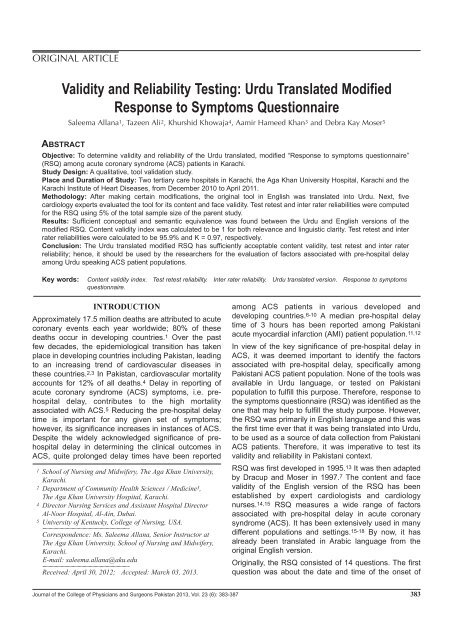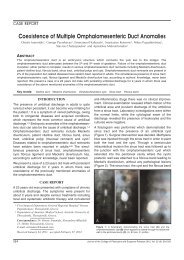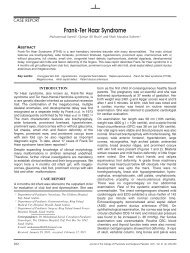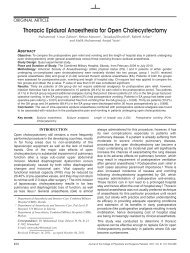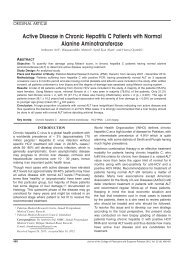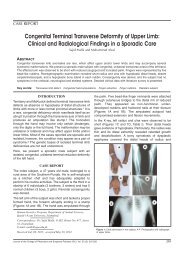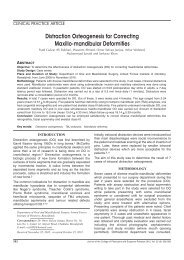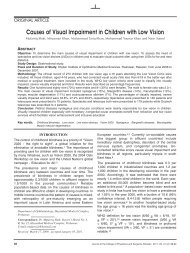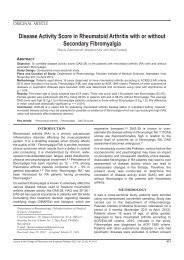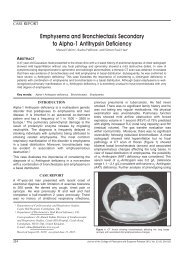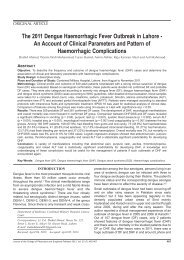Validity and Reliability Testing: Urdu Translated Modified Response ...
Validity and Reliability Testing: Urdu Translated Modified Response ...
Validity and Reliability Testing: Urdu Translated Modified Response ...
Create successful ePaper yourself
Turn your PDF publications into a flip-book with our unique Google optimized e-Paper software.
Saleema Allana, Tazeen Ali, Khurshid Khowaja, Aamir Hameed Khan <strong>and</strong> Debra Kay MoserACS symptoms. Question numbers two to seven weremultiple choice questions regarding the place, <strong>and</strong>witness of symptom onset; initial behavioural responseof the patient to the symptoms; response of attendantsto the patients' symptoms; <strong>and</strong> patients' attribution of thesymptoms to cardiac or non-cardiac causes. The nextfive questions were formulated as Likert scale typequestions, where one indicated no agreement with thestatement, <strong>and</strong> five indicated complete agreement withthe given statement; these questions were about howmuch the specific cognitive <strong>and</strong> affective factorscontributed to their delay. The thirteenth question askedthe respondents to rate their discomfort at the time ofACS symptom onset, on a scale of 0 (no discomfort) to10 (extreme discomfort). In the fourteenth question, therespondents had to indicate if they had knowledge aboutthrombolytics or not.The purpose of this study was to determine the validity<strong>and</strong> reliability testing of the <strong>Urdu</strong> translated, modifiedRSQ, using content validity index (CVI) as a measure ofvalidity <strong>and</strong> test retest <strong>and</strong> inter rater reliabilities asmeasures of reliability.METHODOLOGYThe validity <strong>and</strong> reliability testing was done as part of alarger study, determining the factors associated with prehospitaldelay among ACS patients in Karachi, Pakistan.The larger or the parent study was approved by theEthics Review Committee (ERC) of a tertiary carehospital in Karachi. Permission for data collection wasalso obtained from the sites of data collection.Anonymity was ensured through the use of codes onquestionnaires rather than identity revealing informationlike name, residential address etc. Participants' right ofself-determination was ensured by providing all theinformation related to the study, before seeking consentfrom them.The experts including a cardiologist, the tool developer,<strong>and</strong> an epidemiologist reviewed the RSQ <strong>and</strong> suggestedfew changes in the questionnaire that are listed below;these modifications were made with permission fromDr. Moser (the original tool developer).First of all, it was suggested to add a sociodemographicform <strong>and</strong> a clinical data form to the RSQ as identifiedfrom literature.Secondly, the questions were categorized underrespective headings of cognitive factors, affectivefactors, behavioural factors <strong>and</strong> contextual factors etc.The responses of attendants to the patients' symptomswere grouped together under the respective headings.Some questions were added to the original questionnaire.One of the additional questions, that is, questionnumber two, was in relation to the time taken by thepatient to make the decision to seek care. Similarly,question number four was also added, which was inrelation to the time when patient reached the generalphysician (if sought consultation from the generalphysician). Additionally, four more questions were addedat the end of the RSQ, under the heading of 'otherfactors', which may have influenced the pre-hospitaldelay time in ACS patients, particularly in the Pakistanicontext. The questions asked the participants to rate ona Likert scale of one to five, the importance of thefollowing factors in relation to their delay: being worriedabout the expenses of treatment, distance of patient'sresidence from the hospital, delayed arrival ofambulance, <strong>and</strong> delay due to being caught-up in traffic.The appropriateness of these added questions to thePakistani context was verified by the experts (the tooldeveloper, a cardiologist, <strong>and</strong> an epidemiologist).Finally, under the heading of affective factors, astatement “You delayed because you feared what mighthappen” was modified into a question which read as“How much did you fear the consequences of yoursymptoms?” in order to ensure consistency of languagewithin the category.After making the above mentioned modifications, theRSQ was translated in <strong>Urdu</strong> language by a bilingual(English <strong>and</strong> <strong>Urdu</strong>) language expert. The conceptualequivalence, which is one of the requisites of instrumenttranslation, 19 was verified by a cardiologist who was wellversed both in English <strong>and</strong> <strong>Urdu</strong>.The translated version of the RSQ was then backtranslated into the source language i.e. English, by acardiology nurse who had bilingual expertise; the backtranslator was blinded to the words of the Englishversion of the RSQ. Through back translation, semanticequivalence of the translated tool with the original toolwas assured. 19For content validation, 5 experts from the field ofcardiology were selected. Three of them were cardiologynurses, including a clinical nurse specialist (CNS)working at the Coronary Care Unit for 16 years; headnurse of the Coronary Care Unit, with 8 yearsexperience of being a cardiology nurse; <strong>and</strong> the clinicalnurse instructor (CNI) of the Coronary Care Unit, with 4years experience in cardiology. Two of the experts werethe cardiology physicians, one of whom was acardiologist while the other was a senior cardiologyfellow. The criteria used for the expert review were'relevance of the questions' <strong>and</strong> 'clarity <strong>and</strong> appropriatenessof language for the target population'. Ratingscale was developed for each criterion as per theguidelines derived from Polit <strong>and</strong> Beck. 19 Both thescales were four point Likert scales whereby 1 = notrelevant or not clear, 2 = somewhat relevant or clear,3 = quite relevant or clear <strong>and</strong> 4 = highly relevant orvery clear.384 Journal of the College of Physicians <strong>and</strong> Surgeons Pakistan 2013, Vol. 23 (6): 383-387
Validating the response to symptoms questionnaireFinally, the experts were asked to rate on both the scalesafter due explanation <strong>and</strong> to give suggestions for theimprovement of the questions. All of the experts' ratingswere critically evaluated <strong>and</strong> were matched with thesubjective comments that they had provided for theimprovement of the questions. Experts' suggestionswere further discussed with the research team <strong>and</strong> thosefound to be valid were incorporated into thequestionnaire.The modified questionnaires were given back to theexperts for rating. After obtaining the experts' finalratings on 'relevance' <strong>and</strong> 'linguistic clarity', the CVI wascalculated. 19<strong>Reliability</strong> testing for the <strong>Urdu</strong> translated modified RSQwas done by collecting data for 5% of the total sample(n=249) from the larger study i.e. 12 <strong>and</strong> 13 patients,respectively. As part of the study's eligibility criteria, suchACS patients were selected who were cognitively sound<strong>and</strong> who did not have memory problems. The samplingmethod used for test retest reliability was conveniencesampling, based on patients' stay in hospital after 48hours of their first interview. The patient recruitment forinter rater reliability was done r<strong>and</strong>omly. Data collectionsites were two tertiary care hospitals in Karachi (the AgaKhan University Hospital, Karachi <strong>and</strong> the KarachiInstitute of Heart Diseases); the duration of datacollection was from December 2010 to April 2011.Data was collected for the sociodemographic (age,gender, marital status, educational status, householdmonthly income, <strong>and</strong> status of house), <strong>and</strong> clinicalcharacteristics (diagnosis; history of hypertension,diabetes, angina, <strong>and</strong> previous coronary intervention;smoking status; <strong>and</strong> family history of heart disease) ofthe study participants.For measuring test retest reliability, data was collectedtwice, with a difference of 48 hours between the twoinstances of data collection with the same participants.In order to calculate the inter rater reliability, thequestionnaire was filled by both the primary investigator(PI) <strong>and</strong> the research assistant (RA) simultaneously,for the same participant. The PI was a cardiologynurse doing her graduate studies in Nursing, <strong>and</strong> shewas well aware of the study as it was her own graduatethesis. The RA was a pharmacist with prior knowledgein relation to the ACS symptoms; moreover, shewas rigorously trained by the PI in relation to eachquestion in the questionnaire, through explanation <strong>and</strong>rehearsals.The sociodemographic <strong>and</strong> clinical characteristics of theparticipants mentioned above were analyzed usingdescriptive statistics. Mean <strong>and</strong> st<strong>and</strong>ard deviationvalues were calculated for age <strong>and</strong> householdmonthly income. Frequencies <strong>and</strong> percentages werecalculated for the rest of the sociodemographic <strong>and</strong>clinical variables i.e. for gender; marital status;educational status; status of house; diagnosis; history ofhypertension, diabetes, angina, <strong>and</strong> previous coronaryintervention; smoking status; <strong>and</strong> family history of heartdisease.The CVI was calculated through the proceduredescribed by Polit <strong>and</strong> Beck (2008). 19 First, item contentvalidity indexes (I-CVIs) were calculated for each item inthe questionnaire, by dividing the number of experts whohad given a rating of either 3 or 4 by the total number ofexpert raters. In the next step, all I-CVIs were averagedto calculate the scale content validity index (S-CVI).The test retest reliability was calculated by dividing thenumber of similar observations obtained with adifference of 48 hours, by the total number ofobservations. The inter rater reliability was calculatedthrough the application of Cohen's Kappa. The dataof the participants, for whom two raters had filledthe questionnaires simultaneously, was entered intoStatistical Package for Social Sciences (SPSS) version19 <strong>and</strong> Cohen's Kappa was calculated as a measure ofinter rater agreement. A p-value of 0.05 or less wasconsidered as statistically significant.RESULTSIn the first step of establishing content validity, the CVI ofthe tool was calculated based on the experts' rating,which came out to be 0.94 for 'relevance' <strong>and</strong> 0.9for 'linguistic clarity'. Based on the experts' feedback,changes were made in the questionnaire. Afterincorporating the feedback, the final CVI of the tool wascalculated to be 1 for both 'relevance' <strong>and</strong> 'linguisticclarity' of the items.In total, a sample of 25 patients was utilized to testreliability of the tool. The mean age of the participantswas 54.2 ± 11.23 years. 52% of the participants weremales; whereas, 48% of them were females. Among thestudy participants, 44% were un-educated; while, 56%were educated. The clinical characteristics of theparticipants revealed that 36% of the participantssuffered through ST segment elevation myocardialinfarction (STEMI); whereas, 64% of them have hadeither non-ST segment elevation myocardial infarction(NSTEMI) or unstable angina. 68% of the participantswere hypertensives, 60% had a previous history ofmyocardial infarction (MI) or angina, <strong>and</strong> 64% had apositive family history of heart disease. The demographic<strong>and</strong> clinical characteristics of the studyparticipants are highlighted in Table I <strong>and</strong> II, respectively.The test retest reliability for the <strong>Urdu</strong> translated modifiedRSQ came out to be 95.9%. The Cohen's Kappa for interrater reliability was calculated to be K = 0.97 at p-value< 0.001 (Tables III <strong>and</strong> IV).Journal of the College of Physicians <strong>and</strong> Surgeons Pakistan 2013, Vol. 23 (6): 383-387 385
Saleema Allana, Tazeen Ali, Khurshid Khowaja, Aamir Hameed Khan <strong>and</strong> Debra Kay MoserTable I: Demographic characteristics of participants.Demographic characteristics n (%)25 (100%)Mean age54.2 ± 11.23 years*GenderMale 13 (52%)Female 12 (48%)Marital statusMarried 20 (80%)Single 1 (4%)Widowed 4 (16%)Educational status (years of education completed)No education 11 (44%)1 – 5 years 0 (0%)6 – 10 years 8 (32%)11 – 15 years 5 (20%)16 – 20 years 1 (4%)Mean household monthly income Rs. 22,360 ± 13825.94*Status of houseOwned 15 (60%)Rented 10 (40%)* Mean ± st<strong>and</strong>ard deviationTable II: Clinical characteristics of participants.Clinical Characteristics n (%)25 (100%)DiagnosisSTEMI 9 (36%)NSTEMI 5 (20%)Unstable angina 11 (44%)History of hypertensionYes 17 (68%)No 8 (32%)History of diabetesYes 7 (28%)No 18 (72%)History of MI or anginaYes 15 (60%)No 10 (40%)History of previous angioplasty or CABGYes 2 (8%)No 23 (98%)Smoking statusYes 8 (32%)No 17 (68%)Family history of heart diseaseYes 16 (64%)No 9 (36%)Table III: Inter rater reliability; rater 1 * rater 2 cross tabulation (SPSSoutput).Rater 2Total1.00 2.00 3.00 4.00Rater 11.00 43 1 0 0 442.00 0 33 1 0 343.00 0 0 30 0 304.00 0 0 1 21 22Total 43 34 32 21 130Table IV: Cohen's Kappa calculation (SPSS output).Value Asymp. Std. Approx. T b Approx. Sig.Errora aMeasure of Kappa agreement 0.969 0.018 18.753 0.000N of valid cases 130 – – –DISCUSSIONThe RSQ was translated into the <strong>Urdu</strong> language for thevery first time, therefore, relevance of the questions forthe Pakistani context, <strong>and</strong> their clarity for an averagePakistani was in question. <strong>Testing</strong> the content validity ofthe <strong>Urdu</strong> translated RSQ proved to be a rewardingdecision, as it resulted into quite an improvement ofthe tool, both in terms of relevance <strong>and</strong> linguisticappropriateness of the questions. Many questions weresimplified, rearranged, divided or deleted as per theexperts' suggestions. Moreover, some new questionswere added according to the Pakistani context <strong>and</strong>some existing questions were modified so as to meetthe contextual requirements. The end result was asimplified, underst<strong>and</strong>able, relevant <strong>and</strong> contextuallyappropriate tool. The final CVI of one is an excellentvalidity index as per the literature. 19 These findings areconsistent with the English version of RSQ. 7Moreover, the decision to evaluate the test retestreliability was based on the postulation that there maybe chances of recall bias associated with theparticipants' accounts, as they were being interviewedwithin 48 hours of their admission to the hospital, afterthe acute coronary event. Test retest reliability testingassured that the element of recall bias could not affectthe findings significantly as the test retest reliability cameout to be sufficiently good i.e. 95.9%. 19 This finding isconsistent with the English version of RSQ. 15Adequately good test retest reliability can be attributedto the techniques of data collection, which helped theparticipants to recall the event accurately on bothinstances of data collection. For instance, the time of theonset of symptoms was verified in relation to a dailyroutine ritual, for instance meal time, <strong>and</strong> bed time etc.Moreover, linguistic simplicity of the questions alsohelped the participants to adequately underst<strong>and</strong> thequestions <strong>and</strong> to recall appropriately, on both instancesof data collection.Furthermore, inter rater reliability was done to assurethat there were minimal differences between the ratingsof the two raters i.e. the primary investigator <strong>and</strong> thedata collector. RSQ was found to have a good inter raterreliability. 19,20 The inter rater reliability of the <strong>Urdu</strong>translated version of RSQ is consistent with the Englishversion of RSQ. 15 Such good inter rater reliability can beexplained by the fact that the data collector was trainedrigorously by the researcher; therefore, both PI <strong>and</strong> datacollector had similar underst<strong>and</strong>ing of the questions <strong>and</strong>responses. Moreover, clarity <strong>and</strong> objectivity of the toolalso played its due part in ensuring a good inter raterreliability.386 Journal of the College of Physicians <strong>and</strong> Surgeons Pakistan 2013, Vol. 23 (6): 383-387
Validating the response to symptoms questionnaireCONCLUSIONThe <strong>Urdu</strong> translation of RSQ has excellent CVI, interrater <strong>and</strong> test retest reliabilities. It is recommended thatthe <strong>Urdu</strong> translated version of the modified RSQ shouldbe used in future studies to explore the factor associatedwith pre-hospital delay among <strong>Urdu</strong> speaking ACSpatient populations.Acknowledgement: The authors would like toacknowledge the following experts who helped theauthors with content validity: Dr. Imran Iftikhar(Consultant Cardiologist), Dr. Nabeel Jaffery (ConsultantCardiologist), Ms. Mehrunnissa Imran (Clinical NurseSpecialist, Critical Care), Ms. Anita Khowaja (HeadNurse, Coronary Care Unit), Mr. Rao Farooque (ClinicalNurse Instructor, Coronary Care Unit).REFERENCES1. World Health Organization. WHO country office in Pakistan[Internet]. 2007. Available from: http://www.emro.who.int/pakistan/programmes_ncd.htm2. Ghaffar A, Kazi BM, Salman M. Health care systems in transitionIII. Pakistan, part I: an overview of the health care system inPakistan. J Public Health Med 2000; 22:38-42.3. Lopez AD, Mathers CD, Ezzati M, Jamison DT, Murray CJ.Global burden of disease <strong>and</strong> risk factors [Internet]. 2006.Available from: http://files.dcp2.org/pdf/GBD/GBDFM.pdf4. Ahmad K. Facing-up to Pakistan's cardiovascular challenge.Lancet 2002; 359:859.5. De Luca G, Suryapranata H, Ottervanger JP, Antman EM. Timedelay to treatment <strong>and</strong> mortality in primary angioplasty for acutemyocardial infarction: every minute of delay counts. Circulation2004; 109:1223-5. Epub 2004 Mar 8.6. Dracup K, Moser DK. Treatment-seeking behaviour amongthose with symptoms <strong>and</strong> signs of acute myocardial infarction.Heart Lung 1991; 20:570-5.7. Dracup K, Moser DK. Beyond sociodemographics: factorsinfluencing the decision to seek treatment for symptoms of acutemyocardial infarction. Heart Lung 1997; 26:253-62.8. Noureddine S, Adra M, Arevian M, Dumit NY, Puzantian H,Shehab D, et al. Delay in seeking health care for acute coronarysyndromes in a Labanese sample. J Transcult Nurs 2006; 17:341-8.9. Okhravi M. Causes for pre-hospital <strong>and</strong> in-hospital delays inacute myocardial infarction at Tehran teaching hospitals. AustEmerg Nurs J 2002; 5:21-6.10. Xavier D, Pais P, Devereaux PJ, Xie C, Prabhakaran D, ReddyKS, et al. Treatment <strong>and</strong> outcomes of acute coronary syndromesin India (CREATE): a prospective analysis of registry data.Lancet 2008; 371:1435-42.11. Habib S, Noor A, Madni A, Zaman KS. Delays in thrombolytictherapy among patients with ST-elevation myocardial infarctionpresenting to a tertiary care hospital. Pak J Cardiol 2006; 17:29-39.12. Khan MS, Jafary FH, Faruqui AM, Rasool SI, Hatcher J,Chaturvedi N, et al. High prevalence of lack of knowledge ofsymptoms of acute myocardial infarction in Pakistan <strong>and</strong> itscontribution to delayed presentation to the hospital. BMC PublicHealth 2007; 7:1-8.13. Burnett RE, Blumenthal JA, Mark DB, Leimberger JD, Califf RM.Distinguishing between early <strong>and</strong> late responders to symptomsof acute myocardial infarction. Am J Cardiol 1995; 75:1019-22.14. McKinley S, Moser DK, Dracup K. Treatment-seeking behaviourfor acute myocardial infarction symptoms in North America <strong>and</strong>Australia. Heart Lung 2000; 29:237-47.15. Moser DK, McKinley S, Dracup K, Chung ML. Genderdifferences in reasons patients delay in seeking treatment foracute myocardial infarction symptoms. Patient Educ Couns2005; 56:45-54.16. Banks AD, Dracup K. Are there gender differences in thereasons why African Americans delay in seeking medical help forsymptoms of an acute myocardial infarction? Ethn Dis 2007; 17:221-7.17. Noureddine S, Arevian M, Adra M, Puzantian H. <strong>Response</strong> tosigns <strong>and</strong> symptoms of acute coronary syndrome: differencesbetween Lebanese men <strong>and</strong> women. Am J Crit Care 2008; 17:26-35.18. Noureddine S. Patterns of responses to cardiac events overtime. J Cardiovasc Nurs 2009; 24:390-7.19. Polit DF, Beck CT, editors. Nursing research: generating <strong>and</strong>assessing evidence for nursing practice. 8th ed. Philadelphia:Lippincott Williams & Wilkins; 2008.20. Burns N, Grove SK, editors. The practice of nursing research:Appraisal, synthesis, <strong>and</strong> generation of evidence. 6th ed. Texas:Elsevier; 2009.Journal of the College of Physicians <strong>and</strong> Surgeons Pakistan 2013, Vol. 23 (6): 383-387 387


